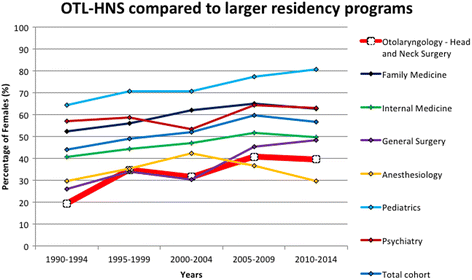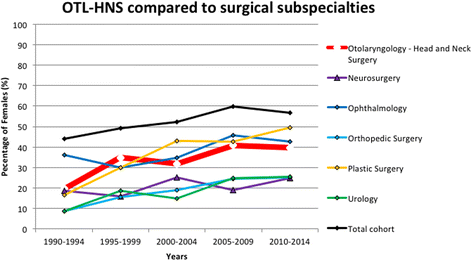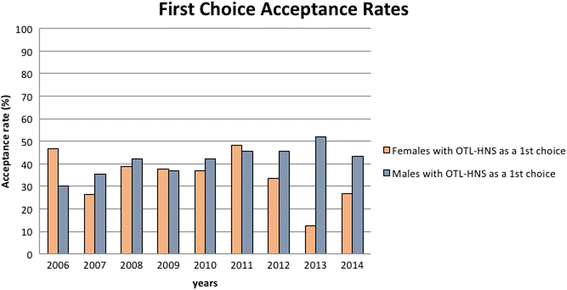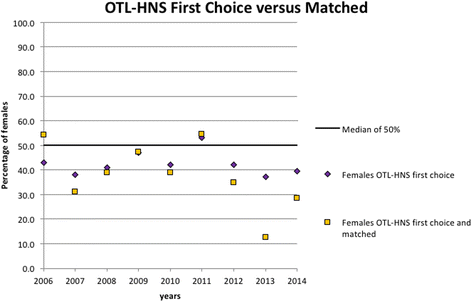Evolution of gender representation among Canadian OTL-HNS residents: a 27-year analysis
- PMID: 28851430
- PMCID: PMC5576270
- DOI: 10.1186/s40463-017-0232-0
Evolution of gender representation among Canadian OTL-HNS residents: a 27-year analysis
Abstract
Background: The proportion of females enrolling into medical schools has been growing steadily. However, the representation of female residents among individual specialties has shown considerable variation. The purpose of this study was to compare the trends of gender representation in Otolaryngology - Head and Neck Surgery (OTL-HNS) residency programs with other specialty training programs in Canada. In order to contextualize these findings, a second phase of analysis examined the success rate of applicants of different genders to OTL-HNS residency programs.
Method: Anonymized data were obtained from the Canadian Residency Matching Service (CaRMS) and from the Canadian Post-M.D. Education Registry (CAPER) from 1988 to 2014. The differences in gender growth rates were compared to other subspecialty programs of varying size. Descriptive analysis was used to examine gender representation among OTL-HNS residents across years, and to compare these trends with other specialties. Bayesian hierarchical models were fit to analyze the growth in program rates in OTL-HNS based on gender.
Results: CaRMS and CAPER data over a 27 year period demonstrated that OTL-HNS has doubled its female representation from 20% to 40% between 1990 and 1994 and 2010-2014. The difference in annual growth rate of female representation versus male representation in OTL-HNS over this time period was 2.7%, which was similar to other large specialty programs and surgical subspecialties. There was parity in success rates of female and male candidates ranking OTL-HNS as their first choice specialty for most years.
Conclusions: Female representation in Canadian OTL-HNS residency programs is steadily increasing over the last 27 years. Large variation in female applicant acceptance rates was observed across Canadian universities, possibly attributable to differences in student body or applicant demographics. Factors influencing female medical student career selection to OTL-HNS require further study to mitigate disparities in gender representation and identify barriers to prospective female OTL-HNS applicants.
Keywords: Diversity; Female; Gender; Minority; Otolaryngology; Residents.
Conflict of interest statement
Ethics approval and consent to participate
Ethical approval was obtained from McGill University Health Centre Institutional Review Board. All data was collected from CaRMS and CAPER databases and therefore consent to participate was not required.
Consent for publication
All authors have consented to have their names appear for the manuscript in the assigned order.
Competing interests
The authors declare that they have no competing interests.
Publisher’s Note
Springer Nature remains neutral with regard to jurisdictional claims in published maps and institutional affiliations.
Figures





Similar articles
-
Securing an OTL-HNS residency: how competitive is it? Comparing medical student perceptions to actual Canadian statistics.J Otolaryngol Head Neck Surg. 2017 Feb 27;46(1):16. doi: 10.1186/s40463-017-0192-4. J Otolaryngol Head Neck Surg. 2017. PMID: 28241867 Free PMC article.
-
Otolaryngology - Head and Neck Surgeon unemployment in Canada: a cross-sectional survey of graduating Otolaryngology - Head and Neck Surgery residents.J Otolaryngol Head Neck Surg. 2014 Sep 16;43(1):37. doi: 10.1186/s40463-014-0037-3. J Otolaryngol Head Neck Surg. 2014. PMID: 25683630 Free PMC article.
-
Perioperative Teaching and Feedback: How are we doing in Canadian OTL-HNS programs?J Otolaryngol Head Neck Surg. 2019 Jan 17;48(1):6. doi: 10.1186/s40463-019-0330-2. J Otolaryngol Head Neck Surg. 2019. PMID: 30654839 Free PMC article.
-
Evaluating Strength of Evidence of Pediatric Otolaryngology Research Literature: A 20-Year Review.Laryngoscope. 2022 Sep;132(9):1869-1876. doi: 10.1002/lary.29945. Epub 2021 Nov 16. Laryngoscope. 2022. PMID: 34784065 Review.
-
Recent Trends in Female and Racial/Ethnic Minority Groups in U.S. Otolaryngology Residency Programs.Laryngoscope. 2021 Feb;131(2):277-281. doi: 10.1002/lary.28603. Epub 2020 Mar 6. Laryngoscope. 2021. PMID: 32144800 Review.
Cited by
-
Assessment of Gender Differences in Perceptions of Work-Life Integration Among Head and Neck Surgeons.JAMA Otolaryngol Head Neck Surg. 2019 May 1;145(5):453-458. doi: 10.1001/jamaoto.2019.0104. JAMA Otolaryngol Head Neck Surg. 2019. PMID: 30896748 Free PMC article.
-
Academic benchmarks for leaders in Otolaryngology - Head & Neck Surgery: a Canadian perspective.J Otolaryngol Head Neck Surg. 2020 May 6;49(1):27. doi: 10.1186/s40463-020-00419-4. J Otolaryngol Head Neck Surg. 2020. PMID: 32375901 Free PMC article.
-
Gender trends in match rate to surgical specialties in Canada: A retrospective study from 2003-2022.PLoS One. 2024 Apr 10;19(4):e0300207. doi: 10.1371/journal.pone.0300207. eCollection 2024. PLoS One. 2024. PMID: 38598528 Free PMC article.
-
The Influence of Sexual Orientation and Gender Identity on the Otolaryngology Residency Experience.OTO Open. 2025 Apr 7;9(2):e70095. doi: 10.1002/oto2.70095. eCollection 2025 Apr-Jun. OTO Open. 2025. PMID: 40196220 Free PMC article.
-
Gender analysis of the top classic papers in otolaryngology head and neck surgery.World J Otorhinolaryngol Head Neck Surg. 2022 Jun 22;9(2):160-167. doi: 10.1002/wjo2.68. eCollection 2023 Jun. World J Otorhinolaryngol Head Neck Surg. 2022. PMID: 37383328 Free PMC article.
References
-
- Canadian Post-MD Education Registry (CAPER). Annual Census Of Post-MD Trainees 2015–2016. https://caper.ca/~assets/documents/pdf_2015_16_CAPER_Census.pdf.
Publication types
MeSH terms
LinkOut - more resources
Full Text Sources
Other Literature Sources
Medical

